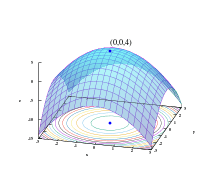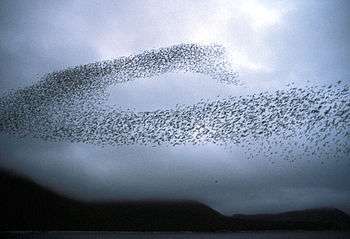Firefly algorithm
In mathematical optimization, the firefly algorithm is a metaheuristic proposed by Xin-She Yang and inspired by the flashing behaviour of fireflies.[1]
Metaphor
The primary purpose for a firefly's flash is to act as a signal system to attract other fireflies. Xin-She Yang formulated this firefly algorithm by assuming:
- All fireflies are unisexual, so that any individual firefly will be attracted to all other fireflies;
- Attractiveness is proportional to their brightness, and for any two fireflies, the less bright one will be attracted by (and thus move towards) the brighter one; however, the intensity (apparent brightness) decrease as their mutual distance increases;
- If there are no fireflies brighter than a given firefly, it will move randomly.
The brightness should be associated with the objective function.
Algorithm
In pseudocode the algorithm can be stated as:
Begin 1) Objective function: ; 2) Generate an initial population of fireflies ;. 3) Formulate light intensity I so that it is associated with (for example, for maximization problems, or simply ;) 4) Define absorption coefficient γ While (t < MaxGeneration) for i = 1 : n (all n fireflies) for j = 1 : n (n fireflies) if (), Vary attractiveness with distance r via ; move firefly i towards j; Evaluate new solutions and update light intensity; end if end for j end for i Rank fireflies and find the current best; end while Post-processing the results and visualization; end
The main update formula for any pair of two fireflies and is
where is a parameter controlling the step size, while is a vector drawn from a Gaussian or other distribution.
It can be shown that the limiting case corresponds to the standard Particle Swarm Optimization (PSO). In fact, if the inner loop (for j) is removed and the brightness is replaced by the current global best , then FA essentially becomes the standard PSO.
Criticism
Nature-inspired metaheuristics in general have attracted criticism in the research community for hiding their lack of novelty behind an elaborate metaphor. The firefly algorithm has been criticized as differing from the well-established particle swarm optimization only in a negligible way.[2][3]
See also
References
- ↑ Yang, X. S. (2008). Nature-Inspired Metaheuristic Algorithms. Luniver Press. ISBN 1-905986-10-6.
- ↑ Lones, Michael A. (2014). "Metaheuristics in Nature-Inspired Algorithms" (PDF). GECCO '14. doi:10.1145/2598394.2609841.
FA, on the other hand, has little to distinguish it from PSO, with the inverse-square law having a similar effect to crowding and fitness sharing in EAs, and the use of multi-swarms in PSO.
- ↑ Weyland, Dennis (2015). "A critical analysis of the harmony search algorithm—How not to solve sudoku". Operations Research Perspectives. 2: 97–105. doi:10.1016/j.orp.2015.04.001.
For example, the differences between the particle swarm optimization metaheuristic and "novel" metaheuristics like the firefly algorithm, the fruit fly optimization algorithm, the fish swarm optimization algorithm or the cat swarm optimization algorithm seem negligible.

